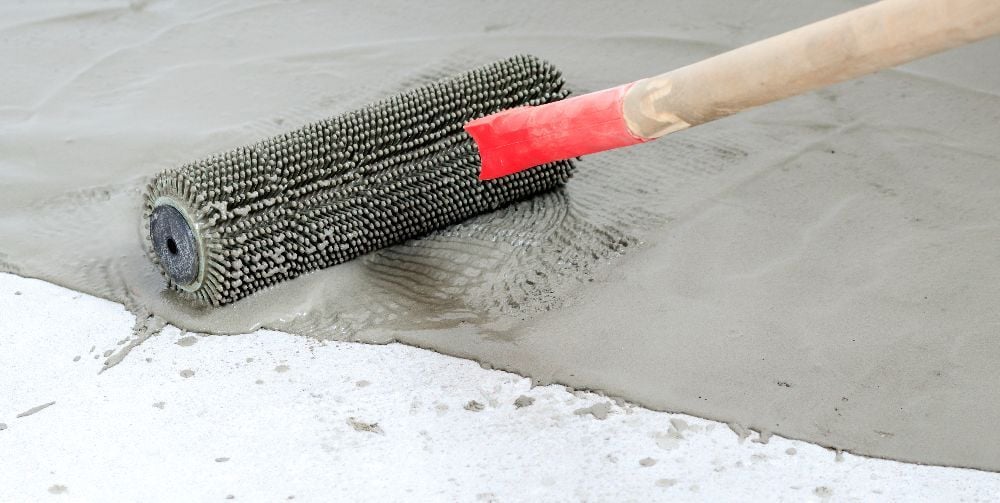Topics:
Search for topics or resources
Enter your search below and hit enter or click the search icon.
Providing your email address will keep you updated should we need to provide updates specific to your location.
December 9th, 2022 | 3 min. read
By Sarah Etler

On the surface, self-leveling concrete seems like an easy and convenient solution to uneven floors, but the truth is, it’s not always so straightforward.
Self-leveling concrete, sometimes called “self-leveling underlayment”, is most commonly used to fill dips and uneven areas on the surface of the concrete in preparation for installing new flooring on top, but in some cases, it can be used as a standalone floor itself.
Here at A-1 Concrete Leveling, our goal is to give you the resources you need to make the best decisions regarding your concrete as possible. With that in mind, we’ve written this article to give you a look at four problems you may face if you decide to use self-leveling concrete.
Related Resource: 4 Ways To Fix Uneven Concrete
One of the main concerns that come with self-leveling concrete is its tendency to crack or crumble. This can be caused by a few different factors, but the main ones are poor bonding between the concrete itself and the newly-poured compound, and movement of the concrete slab.
If the self-leveling compound is poured onto a concrete surface that has not been properly prepared, it will not be able to fully bond to it, and will instead cure as a layer separate from the slab, which will be prone to chipping away from the surface or crumbling. Each self-leveling compound comes with different prep requirements, like adding primer or grinding the surface, for example.
By nature, concrete slabs move and shift as the ground underneath them settles or erodes. If a thin layer of material is cured on top of slabs that are moving, even if it is gradual movement, it can begin to crack or crumble over time.
We have also found that if there are preexisting cracks or expansion joints in the area where the self-leveling compound is being added, this is where it will most likely crack, because the concrete below it is expanding and contracting in these areas.
Another problem that commonly plagues people looking for smooth surfaces with self-leveling concrete is the fact that it’s not ideal for DIY projects.
Although a self-leveling compound will come with specific instructions for its use, due to the difficult-to-perfect nature of the compound, it is not ideal for beginners or DIYers who don’t have prior experience with it.
Self-leveling concrete is hard to mix, as it requires exact measurements with little room for error. If there is too much water in the mixture, it can be overly runny and not set correctly. If there isn’t enough water, it won’t be able to adequately level itself.
Self-leveling concrete is most ideally used indoors because there are more consistent temperatures, which helps with bonding and helps the compound from chipping off as a result of freeze-thaw cycles.
However, even inside, a temperature that’s too hot or too cold or the amount of humidity in the room can also affect how well the product cures.
For most self-leveling compounds, a big benefit to using them is their quick drying times. Instead of waiting days for the new, level surface to cure before installing flooring on top, many self-leveling compounds are ready for use within a few hours of application.
While this is definitely a plus, it brings a challenge, as well. Because of its quick-drying nature, there is less time available for actually working with the product.
Once the water is mixed in, you have to pour and spread the compound almost immediately, as it’s common for self-leveling concrete to have a working window of around 20 minutes. This gives little time for correcting errors or smoothing out any tricky areas.
It’s also important to mention that self-leveling concrete may seem like a complete solution because it masks any issues you have with your concrete, but it is only a superficial layer on top of the existing problems.
Settling slabs or cracks in the concrete don’t go away when self-leveling concrete is applied to the surface, and will likely continue to worsen over time. This is bad news for the self-leveling concrete, as it will deteriorate along with the problematic concrete it’s applied to.
Before a self-leveling compound is applied, it’s crucial to check the concrete for any underlying issues that can be fixed beforehand, as cracks and other deterioration can make it far more likely that the self-leveling concrete will crack, chip, or break down over time.
Now that you know some of the problems associated with self-leveling concrete, you’re more equipped to decide whether or not it’s an option you’d like to explore for your home.
However, before you get started, we recommend that you check out this resource: 4 Ways To Fix Uneven Concrete
Depending on the specific problem you're facing and the cause of the uneven concrete, one of the solutions discussed there may be a better solution for you.
Sarah Etler joined A-1 Concrete Leveling after receiving her Bachelor of Arts degree in English from Northern Kentucky University. As A-1's Content Marketing Manager, she works closely with industry experts to produce content that will best answer questions related to concrete repair and maintenance practices. Sarah loves living a life full of discovery and is excited every day to see what new things she can learn and share with those around her.
Topics: